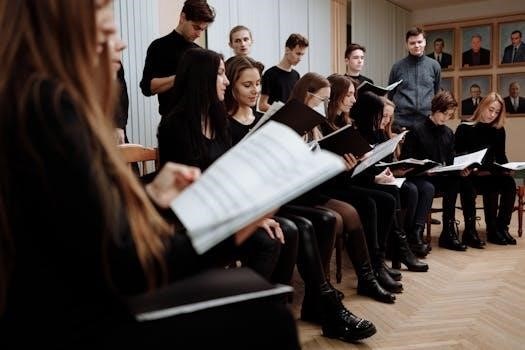Practical Method of Italian Singing ⎼ Soprano PDF
Nicola Vaccai’s renowned “Practical Method of Italian Singing” is a cornerstone for soprano vocal training. This method‚ often found in PDF format‚ provides exercises essential for developing vocal technique. It focuses on breath control and agility‚ crucial for mastering Italian vocal pieces. The method is highly valued in vocal academies worldwide.
Nicola Vaccai’s Influence on Vocal Pedagogy
Nicola Vaccai‚ an Italian composer‚ singer‚ and vocal pedagogue‚ significantly impacted vocal pedagogy through his “Practical Method of Italian Singing.” Published in 1833‚ this method became a cornerstone for vocal training‚ especially within the context of Italian opera. It is widely acknowledged for its systematic approach‚ providing singers with a structured path to developing their vocal abilities. Vaccai’s method emphasizes the importance of understanding the Italian language‚ particularly its vowel sounds‚ as they directly influence vocal production and tone quality. His work offers a collection of vocal exercises designed to extend range‚ increase agility‚ and improve breath support‚ all crucial elements for any aspiring vocalist. This method‚ still used today‚ underscores his lasting influence. Furthermore‚ Vaccai’s approach is not just about technical proficiency; it also delves into the artistic nuances of singing‚ focusing on expression and musicality. This holistic view made his method a favorite amongst both teachers and students‚ cementing its place as a landmark in vocal training. The availability of his work in PDF formats has only increased its accessibility.
Historical Significance of Vaccai’s Method
The “Practical Method of Italian Singing” by Nicola Vaccai holds a significant place in the history of vocal pedagogy. Published in 1833‚ during a time when Italian opera and bel canto singing were highly revered‚ Vaccai’s method provided a much-needed systematized approach to vocal training. It emerged as a crucial resource for aspiring opera singers‚ particularly sopranos‚ who required extensive technical skills and vocal agility. This method was not merely a set of exercises; it was a comprehensive guide that addressed the fundamental aspects of singing‚ including breath control‚ vocal resonance‚ and clear articulation. The historical impact of Vaccai’s work is underscored by its continued use in vocal academies and conservatories worldwide. It serves as a link to the traditions of the old Italian school of singing‚ passing down principles that have shaped generations of vocalists. Its persistence speaks volumes about its effectiveness and the timelessness of its teaching. The availability in PDF format further ensures accessibility for modern singers. Vaccai’s legacy is firmly cemented in the annals of vocal history.
Availability of Vaccai’s Method in PDF Format

The accessibility of Nicola Vaccai’s “Practical Method of Italian Singing” in PDF format has significantly broadened its reach‚ making this historical vocal training resource available to a global audience. The digital format allows aspiring singers and educators to easily download and use the method‚ eliminating the limitations of physical copies. This shift to digital distribution has democratized access to quality vocal instruction‚ enabling individuals in various geographical locations to benefit from Vaccai’s expertise. The PDF format also makes it convenient to search through the method‚ print specific exercises‚ and even annotate them digitally. Furthermore‚ the availability of various editions in PDF format provides singers with options to choose a version that best suits their needs. The digital medium has ensured that this classic text is not only preserved but also actively used‚ maintaining its relevance in modern vocal pedagogy. The convenience and wide availability of the method in PDF format is a testament to its enduring value. It ensures that the wisdom of the old Italian school of singing continues to be passed down.
Content of Vaccai’s Practical Method
Vaccai’s “Practical Method of Italian Singing” is meticulously structured‚ offering a progressive approach to vocal development. It encompasses a series of vocal exercises specifically designed to address various aspects of singing technique. The method is not just a collection of random drills‚ but a carefully curated sequence aimed at building a solid foundation for vocal performance. The exercises cover a range of vocalises‚ focusing on agility‚ breath control‚ and intonation. It introduces progressively complex musical phrases‚ allowing singers to gradually build their vocal skills. Each exercise is designed to be practiced with attention to detail and musicality. The method also emphasizes the importance of understanding the Italian language‚ as it is integral to the musicality of the exercises. The content includes both technical exercises and musical phrases‚ promoting the development of both technical proficiency and artistic expression. This dual focus ensures that singers not only achieve technical mastery but also cultivate the ability to sing with feeling and artistry. Vaccai’s method is a comprehensive guide to mastering the art of singing.
Vocal Exercises for Soprano Training
The vocal exercises within Vaccai’s method are specifically tailored for soprano voices‚ addressing the unique demands of this vocal range. These exercises are not just random vocalizations; they are structured to systematically develop key aspects of soprano singing technique. They include scales‚ arpeggios‚ and melodic passages designed to improve range‚ agility‚ and breath control. The exercises encourage precision in pitch and rhythm‚ crucial for accurate and expressive singing. Furthermore‚ they focus on achieving a smooth legato and clean articulation‚ enhancing the overall musicality of the performance. Each exercise is a step towards a more refined and controlled vocal technique‚ building a foundation for singing complex pieces. Regular practice of these exercises helps sopranos develop the necessary strength‚ flexibility‚ and stamina for sustained and demanding performances. The exercises are designed to be challenging yet achievable‚ allowing sopranos to gradually improve their vocal abilities. Vaccai’s approach is methodical‚ ensuring that each exercise contributes to the overall development of a well-rounded soprano voice. These exercises are fundamental to the method’s effectiveness.
Focus on Breath Control and Agility
A central element of Vaccai’s method is its emphasis on developing breath control and vocal agility‚ crucial for any aspiring soprano. The exercises are crafted to enhance the singer’s ability to manage their breath efficiently‚ ensuring they can sustain long phrases and control dynamics without strain. Proper breath support is the foundation for a strong and resonant tone‚ allowing for a wide range of expression. Agility exercises‚ on the other hand‚ are designed to improve the singer’s ability to navigate rapid passages and intricate melodic lines with ease and precision. These exercises often involve scales‚ arpeggios‚ and rapid note repetitions‚ challenging the singer to execute complex vocal patterns smoothly and accurately. The combination of breath control and agility training equips sopranos with the tools necessary to perform challenging repertoire with technical mastery and musical expressiveness. The method’s systematic approach ensures that these skills are developed progressively‚ allowing singers to build a solid foundation for advanced vocal work. These are vital for achieving professional level performances.

Italian Language and Vocal Technique
The connection between the Italian language and vocal technique is fundamental in Vaccai’s approach. The very structure of the Italian language‚ with its clear vowels and flowing consonants‚ naturally encourages good vocal production. The exercises in Vaccai’s method are often set to simple Italian texts‚ allowing singers to not only practice technical skills but also to internalize the natural resonance and flow of the language. This integration of language and technique is intentional; the method aims to develop a vocal style that is both technically proficient and musically expressive within the context of Italian singing. The focus on vowels‚ in particular‚ helps singers achieve a pure and sonorous tone‚ while the consonants are used to articulate clearly without disrupting the vocal line. The method’s emphasis on legato singing also aligns perfectly with the lyrical quality of the Italian language‚ further solidifying the bond between language and technique. This holistic approach is a key reason why Vaccai’s method remains a staple in vocal training worldwide. It provides a systematic way to improve vocal skills while simultaneously mastering the nuances of the Italian vocal tradition.

Different Editions and Publishers of Vaccai’s Method
Vaccai’s “Practical Method of Italian Singing” has been published by numerous houses over the years‚ leading to a variety of editions‚ each with its own characteristics. Early editions‚ such as those from G. Schirmer and G.D. Russel & Co.‚ are historically significant and can offer insights into the original intent of the work. Later publishers‚ such as Steingräber‚ have also contributed to the method’s widespread availability. These editions can differ in terms of layout‚ presentation‚ and the inclusion of additional textual notes or translations. Some editions may also be specifically geared towards different voice types‚ like soprano or tenor‚ or include variations for mezzo-soprano and alto/baritone. The availability of the method in PDF format has further democratized access‚ allowing singers worldwide to benefit from Vaccai’s pedagogical approach. When choosing an edition‚ singers should consider factors such as the clarity of the print‚ the inclusion of translations‚ and any supplementary material that may be provided. It is also worth noting that some editions may have slightly different arrangements or interpretations of the original exercises‚ making it important to compare different versions and find one that suits the individual singer’s needs and preferences. The variety in publishing ensures that Vaccai’s legacy continues to reach new generations of singers.
Practical Application of the Method
The practical application of Vaccai’s method involves consistent and disciplined practice of the vocal exercises. Singers typically begin with the basic exercises‚ focusing on achieving a clear and resonant tone‚ proper breath control‚ and accurate intonation. The method emphasizes the legato style‚ which is crucial for Italian singing. Singers are encouraged to gradually increase the difficulty of the exercises as they improve‚ always paying close attention to maintaining good vocal technique. The exercises are not only for developing technical skills but also for training the ear and improving musicality. Many vocal coaches integrate Vaccai’s exercises into their teaching‚ using them as a foundational tool for developing young singers. The method’s focus on the Italian language also helps singers become more fluent in the nuances of Italian diction‚ which is essential for performing Italian opera and art songs. Furthermore‚ the method can be effectively used in combination with other vocal methods‚ providing a comprehensive approach to vocal training. Consistent practice with Vaccai’s method helps singers to build strength‚ agility‚ and control‚ enabling them to tackle more challenging repertoire with confidence. The practical applications are numerous and beneficial for vocalists at all levels.
Use of Vaccai Method in Vocal Academies
The Vaccai method holds a prominent place in vocal academies around the world‚ serving as a fundamental component of soprano training programs. Its structured approach and comprehensive exercises make it an ideal tool for both novice and advanced students. Vocal academies often incorporate Vaccai’s exercises into their curriculum‚ using them to establish a strong technical base for all students. The method is particularly valued for its focus on breath control‚ legato singing‚ and clear articulation‚ all of which are essential for mastering the art of singing. Instructors in these academies typically use the exercises to help students develop vocal agility and flexibility‚ as well as to improve their range. The method is also used to teach proper Italian diction‚ which is crucial for those aspiring to perform in the operatic tradition. Furthermore‚ the Vaccai method’s historical importance gives students a deeper understanding of the lineage of vocal pedagogy. Many academies include the study of Vaccai as part of a broader program that includes other vocal methods and techniques. The consistent use of this method ensures a high standard of vocal training‚ producing singers who are well-prepared for professional careers. The method’s practicality and proven effectiveness make it an invaluable tool in vocal academies.
Translations and Textual Notes in Editions

Various editions of Vaccai’s “Practical Method of Italian Singing” often include translations and textual notes‚ making the method accessible to a broader range of singers‚ particularly those not fluent in Italian. These translations typically provide English versions of the exercises‚ allowing students to understand the text’s meaning while focusing on vocal technique. Many editions include both the original Italian text and its English translation side-by-side‚ which is invaluable for students learning the nuances of Italian diction. The textual notes in these editions frequently provide additional context‚ explanations‚ and performance suggestions. These notes may clarify the purpose of specific exercises‚ offer tips on how to approach challenging passages‚ or provide historical background on the method’s development. Some editions also include comparative notes‚ highlighting differences in interpretation or performance practice. These textual notes can significantly enhance a student’s understanding of the method and improve their overall vocal training. The availability of both translations and textual notes ensures that singers can fully grasp Vaccai’s teachings‚ regardless of their linguistic background. The textual notes also serve as a guide for proper vocal technique and musical interpretation. These elements are important for a comprehensive understanding of the Vaccai method.
